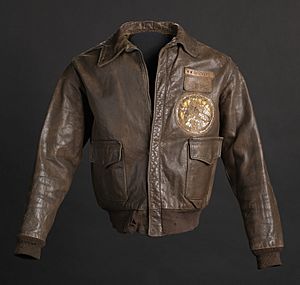Woodrow Crockett facts for kids
Quick facts for kids
Woodrow W. "Woody" Crockett
|
|
|---|---|
| Born |
Woodrow Wilson Crockett
August 31, 1918 Homan, Arkansas, U.S.
|
| Died | August 16, 2012 (aged 93) Washington, D.C., U.S.
|
| Resting place | Arlington National Cemetery, Section 59, Site 31, Arlington, Virginia |
| Occupation |
|
| Years active | 1940–1970 |
Woodrow Wilson Crockett (born August 31, 1918 – died August 16, 2012), pronounced "Crow-Ket," was a brave American pilot. He was an officer in the U.S. Army Air Force and later the U.S. Air Force. He is famous for being a fighter pilot with the Tuskegee Airmen. These were a special group of all-African American pilots during World War II. They were also known as the "Red Tails."
Woodrow Crockett was one of 1,007 pilots who trained at Tuskegee. He also made history on June 2, 1959. He was one of the first U.S. military pilots to fly at Mach 2 speeds. This means he flew twice the speed of sound!
Contents
Early Life and Family
Growing Up in Arkansas
Woodrow Crockett was born on August 31, 1918, in Homan, Arkansas. His family called him "Woody." He was named after President Woodrow Wilson. His parents, William and Lucindan Crockett, were both school teachers. Woodrow was the fifth of their six children.
He went to school in Homan until the eighth grade. Then, he moved to Little Rock, Arkansas to live with his older sister. This allowed him to attend Dunbar High School. It was one of the few high schools for African Americans in Arkansas at that time.
College and Early Work
After finishing high school in 1939, Crockett went to Dunbar Junior College. He studied mathematics and hoped to earn a PhD. However, in 1940, he had to leave college. He was working 12 hours a day as a dishwasher, but he still couldn't afford the tuition.
His Family Life
Woodrow Crockett was married to Daisy Juanita McMurray Crockett. She passed away in 2000. They had three daughters named Marcia, Rosemary, and Kathleen. They also had a son, Woodrow W. Crockett Jr.
Military Career
Joining the Army
In 1940, Crockett joined the U.S. Army. He was part of the 349th Field Artillery Regiment, which was an all-African American unit. He served as an artilleryman.
Becoming a Tuskegee Airman
Crockett saw a flyer asking for pilots. In August 1942, he transferred to the pilot training program at Tuskegee. On March 25, 1943, he successfully finished his training. He earned his pilot wings and became a 2nd Lieutenant. He was then assigned to the 100th Fighter Squadron, part of the 332nd Fighter Group. He was the second person from Arkansas to graduate from the Tuskegee pilot program.
Flying in World War II
During World War II, Crockett flew an amazing 149 missions in just 15 months. In June 1944, during a mission, his squadron commander, Lieutenant Robert B. Tresville, crashed. Crockett bravely took temporary command of the 100th Squadron. Another pilot, Andrew D. Turner, later took over as the permanent commander.
Service in Korea and Beyond
Crockett also flew 45 missions during the Korean War. He served in many different roles at various U.S. Air Force bases. He worked as a safety officer for flying and for radiation. He was even in the air during atomic bomb tests in the Marshall Islands.
He also studied at the U.S. Air Command and Staff College. In 1958, he helped test the F-106 jet at Edwards Air Force Base in Edwards, California. On June 2, 1959, he became one of the first pilots to fly at Mach 2 speeds. He also spent some time working with NATO (North Atlantic Treaty Organization) in Oslo, Norway.
From 1960 to 1970, Crockett worked with the Pentagon. He helped to bring different groups of the Air National Guard together.
Retirement from Service
In 1970, Crockett retired from the Air Force. He held the rank of Lieutenant Colonel. He had flown for over 5,000 hours and spent 520 hours in combat.
Achievements After the Military
Awards and Honors
After his military career, Woodrow Crockett continued to be recognized for his achievements.
- In 1992, he was the first African American to be added to the Arkansas Aviation Hall of Fame.
- In 1994, he traveled with President Bill Clinton to France. They attended events marking the 50th anniversary of World War II's D-Day.
- In 1995, he was inducted into the Arkansas Black Hall of Fame.
- In 2001, the University of Arkansas at Little Rock gave him an honorary doctorate degree.
Congressional Gold Medal
In 2007, Woodrow Crockett and all the other Tuskegee Airmen received a very special award. They were given the Congressional Gold Medal. This is one of the highest honors a civilian can receive in the United States.
Military Awards
Woodrow Crockett earned many awards for his bravery and service:
- Distinguished Flying Cross
- Presidential Unit Citation
- Soldier's Medal (for saving pilots from a burning plane in Italy in 1944)
- Soldier's Medal (for saving pilots from a burning plane in Korea in 1953)
- Air Medal with four oak leaf clusters
- Meritorious Service Medal
- Army Commendation Medal
- Air Force Commendation Medal with one oak leaf cluster
Death
Woodrow Crockett passed away on August 16, 2012. He died from Alzheimer's at a military retirement community in Washington, D.C.. He and his wife, Daisy Juanita McMurray Crockett, are buried together at Arlington National Cemetery.
Legacy
Woodrow Crockett's World War II flight suit is on display. You can see it at the National Museum of African American History and Culture in Washington, D.C. It helps tell the story of his amazing life and the brave Tuskegee Airmen.
See also
- Tuskegee Airmen
- List of Tuskegee Airmen Cadet Pilot Graduation Classes
- List of Tuskegee Airmen
- Military history of African Americans
- Dogfights (TV series)
- Executive Order 9981
- The Tuskegee Airmen (film)


